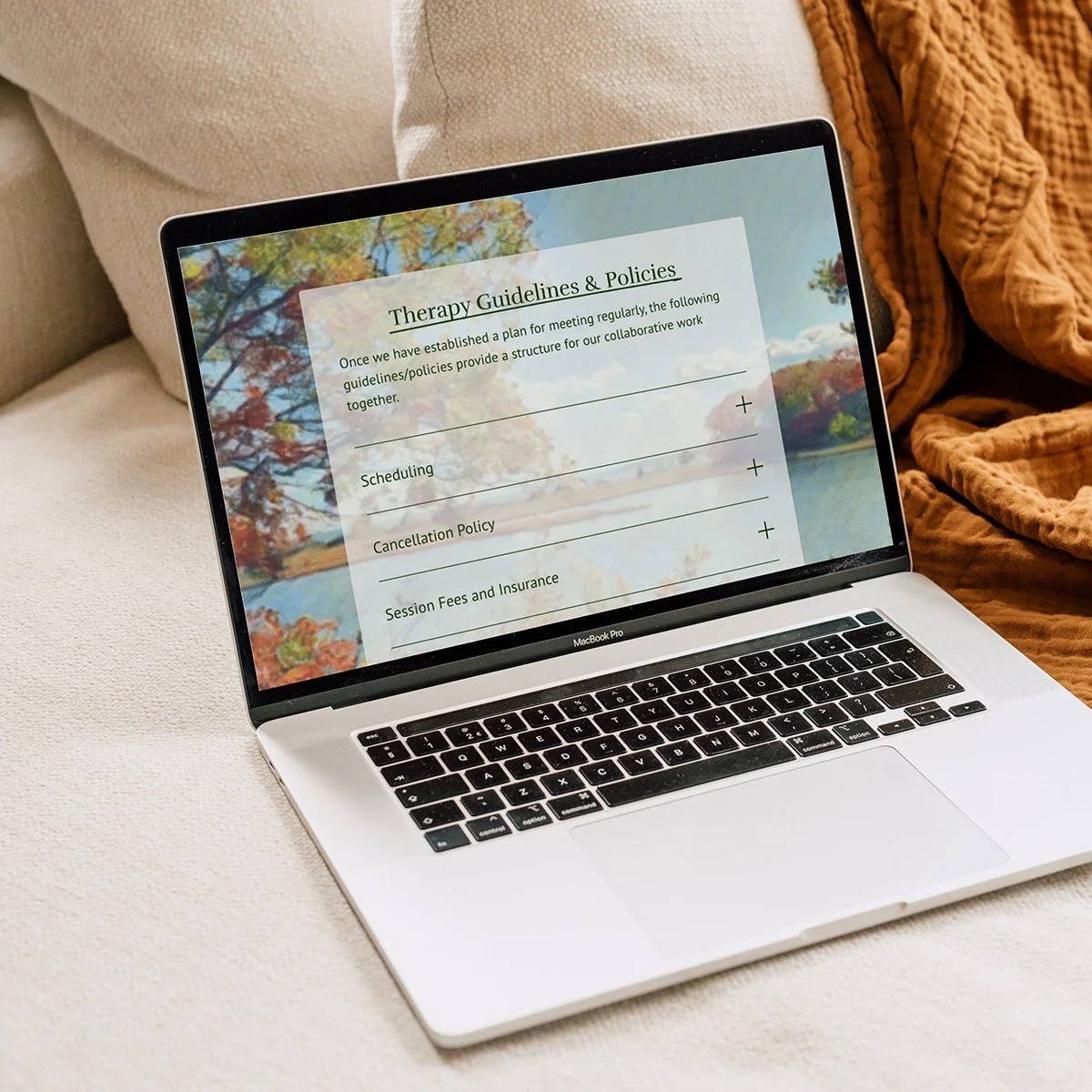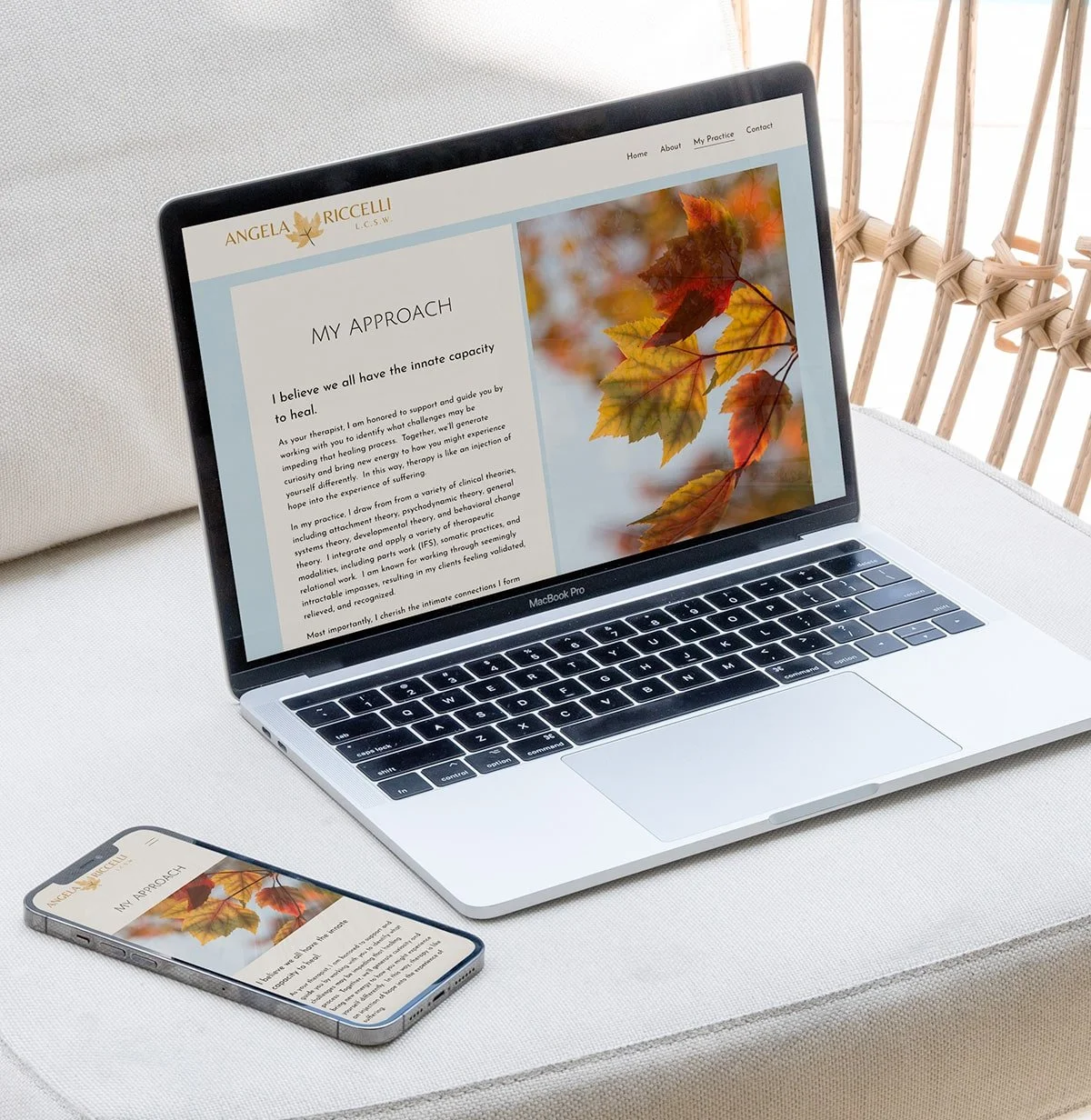5 tricks to make your therapist website uniquely yours ✨
Let’s be honest… a lot of therapist websites are starting to look the same. After all, there are only so many stock images of oceans, stacked rocks, and random people standing with their arms outstretched on a mountaintop 😜.
Having worked as a therapist myself, I know how important it is for your website to genuinely feel like you. It’s not just about looking professional— it’s about showing up authentically, so you attract and connect with the right clients in a way that is honest and ethical.
As a custom website designer for therapists, I support my clients in creating an online presence that is professional, ethical, and authentic. Here are five fun tips to make your website feel more you— and draw in your dream clients.
1) Use your own photography
You might be thinking that the iPhone photos you took on your family vacation last summer aren’t professional website material, but that’s exactly what I did for psychologist Judy Glinder’s custom website. With the help of AI, I “watercolorized” Judy’s photo of the special lake that her family visits every year, transforming it from a regular iPhone photo into vibrant background artwork.
Using your own photography not only makes your site stand out to prospective clients, but it will give you a little dose of delight every time you look at it. And we can all use a little more delight in our lives!
When you can’t use your own photography, opt for artwork over stock photography, which can feel inauthentic and “salesy”. Many sites, such as iStock, offer beautiful digital artwork to purchase.
Featuring artwork as a visual motif throughout your website is another way for you to show prospective clients who you are. As a yoga practitioner with a love for Japanese art, Judy Glinder’s watercolor bamboo imagery creates a soothing visual effect that reflects her interests and personality.
Web Designer Words of Wisdom: For any image used on your site, you’ll want to optimize its size to maintain its quality while ensuring it’s not so large that it negatively impacts site performance. You can read more about sizing your website images here. In addition, make sure to include “alt text” for any images that communicate important information or act as links, to ensure your website is accessible to all users. Here’s a Squarespace guide to writing alt text for images.
2) Instill meaning into your logo
For therapists and other mental health professionals, a logo is not just a branding tool; it’s an opportunity to personalize and add meaning to your website. Your logo should have special significance to you. It could symbolize your approach to therapy, your cultural background, your passions, or your values. Whatever it is, instill it with meaning.
For example: fall foliage carries deep significance to Angela Riccelli, who was born and raised in the Northeastern United States. Her logo, which features a maple leaf, conjures cherished childhood memories of collecting fallen leaves.
To compliment Angela’s logo, we decided to use the autumn foliage as a visual motif throughout her site. The changing leaves are both a nod to her New England roots and a symbol of life’s impermanence — a common theme in Angela’s work as an individuals and couples therapist.
Don’t forget to consider how your logo will compliment the colors, textures, typography, and styles of your website. When thoughtfully integrated, your logo and website styles will create a consistent and memorable visual tone —one of the main differentiators between a DIY website and a professionally-designed custom website.
Web Designer Words of Wisdom: When designing your logo, you’ll want to create at least a couple different layouts and color schemes to fit different contexts (i.e. light and dark themes). Make sure your logo meets color contrast guidelines, to ensure that your logo is accessible to people with visual impairments.
3) Use an accent font to capture your voice
Typography can be a great tool to highlight important points, create visual interest, and convey tone. I recommend choosing 3 complimentary fonts for your website:
a heading font for titles and subtitles,
a paragraph font for regular text, and
an accent font to accentuate small snippets of text.
While your heading and paragraph font should to be optimized for standardization and readability, an accent font is a great opportunity to get a little more creative!
Notice how Angela Riccelli’s website uses a handwriting-style accent font to highlight her voice and add visual interest. Accent fonts are great for conveying tone, and her use of Adobe Handwriting Ernie creates a sense of approachability with a hint of playfulness. It gives us a little taste of Angela’s personality.
If you’re wondering where to start, try Googling “handwriting fonts” or “script fonts” to see which fonts you like. Make sure you include your website builder (i.e. Squarespace, Wix, etc.) in your search, since not all platforms support all fonts. This blog post shows examples of some handwriting fonts available in Squarespace.
Web designer Words of Wisdom: Fonts can negatively impact your website’s performance (loading speed). Avoid using too many fonts, or try using “web safe” fonts to improve your site’s performance.
4) Share who you are!
My clients often ask me, “just how ‘real’ should I be on my website?” Finding the right balance of authenticity and professionalism is one of the challenges of designing a therapist website. When I was completing my clinical internship, one of my biggest takeaways was the importance of showing my authentic self. As a White woman working in marginalized communities, I worried that acknowledging my privilege might distance me from my clients. But the opposite was true: by owning my identities and sharing my personality, background, and life experiences, we were able to build deeper trust and bridge the gaps to deeper connection. The same is true for your website!
The process of building trust starts with your website. It is important to give prospective clients an honest impression of who you are both within and outside of your work as a therapist so they can intentionally choose you. By leading with authenticity, you set the foundation for clients to feel comfortable being vulnerable with you.
By sharing who you really are, the right clients will think, “oh yes, this is the exact person I want to work with!”
For example, Elizabeth Johnston’s “About me” page shares that she is “a wife, a mom, nature-lover, pet lover, aspiring interior designer, fitness enthusiast, and nutrition buff”. Elizabeth strikes the perfect balance of thoughtful self disclosure and maintaining appropriate boundaries. Future clients might see her identities as a wife and a mother, or her interest in interior design, as points of connection.
Web Designer Words of Wisdom: Many therapists find copywriting to be the most challenging aspect of building their website. If you’re struggling to find the right words, consider working with a web designer/copywriter. My copywriting services involve informal conversations in which we dive deep into your practice to identify what makes you you, which I’ll then organize and distill into concise and powerful language for your website — without sounding too generic, salesy, or wordy.
5) Stuck? Try starting with a quote.
The hardest part is getting started. If you’re stuck in the planning phase, take a step back and see if you can find a quote that truly embodies your practice. A quote can serve as a great springboard to help you hone in on your message and uncover your visual theme.
Trust me, it can help!
In our initial consultation for her new Ketamine-Assisted Therapy webpage, Elizabeth Johnston shared her love for the Rumi quote, “Maybe you are searching among the branches, for what only appears in the roots”.
Drawing on this quote for inspiration, we designed her webpage around the theme of trees, representing personal growth, and roots, symbolizing the unconscious patterns that shape who we are. The language and tone of the entire page speaks to those that are seeking answers to their deepest questions, suggesting the answers may lie below the surface of conscious awareness
Quotes are also a powerful way to connect with prospective clients. On Judy Glinder’s site, each page features a unique quote aligned with its topic. The quotes convey Judy’s therapeutic approach and values in a way that is concise and visually interesting. They create a consistent and memorable design paradigm that both improves the user experience and sets a contemplative tone fitting with Judy’s personality and style.
Web Designer Words of Wisdom: Be mindful of intellectual property laws when using quotes on your website. Generally, you can legally use well-attributed famous quotes on your website that fall under the public domain. However, if the quote is from a more recent work, or if you’re unsure whether it falls under public domain, it is always good practice to ask for permission from the author.
And don’t forget to ask for feedback!
Your friends, family, mentors, and colleagues know you best. Ask them, “Does this feel and sound like me?”. This is often the clearest barometer on whether you’re website is coming across authentically.
If you’re working with a professional designer, don’t be afraid to give them feedback. While they may be the “expert” when it comes to building your site, only you know you best. A great designer will know how to integrate their expertise with your unique tastes, values, and needs.
🙋 Need a little extra help?
Now offering 1:1 live Squarespace support for therapists! Learn more about my services.
✨ Try out these tips and let me know how it goes in the comments! ✨
Maggie Goulder | custom web designer for therapists
Maggie Goulder is a web designer specializing in websites for mental health professionals. As a Social Work graduate and a former User-Experience designer, her unique blend of clinical experience and web design expertise allows her to support therapists in bringing their practices online in a way that is authentic, ethical, and naturally attracts the right clients. Known for deeply listening to her clients, Maggie’s style is collaborative, thoughtful, detail-oriented, and supportive. In addition to custom websites, Maggie offers SEO, Web Accessibility, Copywriting, Logo Design, and other web services for therapists.








